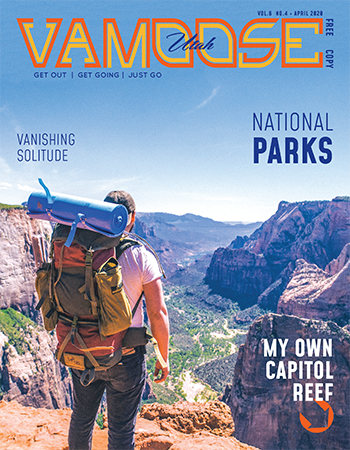Daytripping through the wild horse country of Skull Valley.
By Robert Hammer
One Sunday morning in late June, three parched and weary men staggered eastward across a sage-covered valley some 40 miles south of the Great Salt Lake. What little water they had found the previous day proved undrinkable, leaving one of their party unable to continue as the sun arced murderously toward noontime. A steady diet of hot saline dust was beginning to cloud their faculties, but their fundamental options still loomed in perfect clarity: find a potable water source to slake their life-threatening thirst or succumb to the broiling playa and wait for the turkey vultures to arrive.
This nearly tragic culmination of Jedediah Smith’s 1827 trek across the Great Basin marked the first appearance of European Americans in Skull Valley. Smith found water and returned to his companions in time to deny the vultures that day, and the trio continued safely to the trappers’ summer rendezvous at Bear Lake.
Thirty-two years later, Capt. James H. Simpson set westward from Camp Floyd to establish a direct military route to California, paralleling Smith’s path through Skull Valley and across Nevada. Simpson’s relatively well-watered Central Overland Route was immediately adopted by the nascent Pony Express Service and would remain the preferred path to northern California until the transcontinental railroad was completed in 1869. Sir Richard Burton, Samuel Clemens and just about everyone else traveling to Carson City or San Francisco through the 1860s would have passed along this ingress to a forbidding region that early cartographers dubbed The Great American Desert.
Today, the Pony Express Trail National Backcountry Byway includes this storied path through Utah’s West Desert, providing ready access to a variety of historical sights and wilderness activities. You can begin a daytrip along this route much as Mark Twain might have in 1861, with a visit to the Stagecoach Inn at Fairfield, now part of the Camp Floyd Stagecoach Inn State Park.
From Camp Floyd, the byway follows Utah Highway 73 for about five miles before veering left onto the gravel road toward Faust. A short, paved jaunt south from Faust along Highway 36 picks up the gravel trail again, westward toward the Fish Springs Wildlife Refuge. Rising ahead, the Onaqui (AH-nuh-kee) Mountains mark the eastern border of the physical heart and essential soul of this excursion: the Onaqui Mountains wild horse herd area.
Stone-and-mortar obelisks appear at roughly 10-mile intervals along this trail, marking the locations of remount stations, where Pony Express riders would mount fresh steeds to carry them to the next post. The U.S. Cavalry and overland stage services likewise maintained remount stations, ensuring fresh horses at reliable intervals all the way to California. The Onaqui herd, along with their Cedar Mountain cousins to the north and numerous herds across central Nevada, undoubtedly descend from horses that either escaped or were released from those military and commercial outposts. These living monuments to the opening of the American West are protected by the Wild Free Roaming Horses and Burros Act of 1971. Onaqui is one of over two dozen designated herd areas throughout Utah administered by the Bureau of Land Management.
Although not uncommon within the eastern foothills, mustang sightings grow increasingly likely as you proceed westward beyond Lookout Pass and descend into Skull Valley. You’ll know you’re entering prime mustang-viewing country when you begin to see pyramidal droppings, or “stud piles,” along the well-groomed gravel road. Large groups, sometimes exceeding 100 horses, favor the areas surrounding Simpson Springs, situated a few miles south of the Dugway Proving Ground.
Standing midway between Camp Floyd and the Fish Springs Wildlife Refuge, the Simpson Springs Recreation Area offers the perfect opportunity to stretch your legs, answer nature’s call and learn more about the trail you are following. Named after the man who surveyed the Central Overland Trail, this site includes a replica of the way station that stood on this location, where Pony Express riders would pass their packets on to the next rider, spending the night before returning to their home station. The spring-fed pond a half-mile northwest of the parking lot is a popular watering hole among the 500 horses calling this area home. Camping is also available on improved lots in the foothills southeast of the main road at $15 per night.
Mustang country straddles the road for 30 miles southwest from Simpson Springs, so keep your camera and binoculars handy as you proceed to Fish Springs. A genuine desert oasis for waterfowl and raptors, the Fish Springs Wildlife Refuge includes a self-guided automobile tour and picnic areas.
With Simpson Springs conveniently located halfway between Fairfield and Fish Springs, this enjoyable 180-mile roundtrip drive can be completed in four easy legs of 60 to 90 minutes.
For more information on Utah’s wild horse herd areas and free travel guides, visit WildHorseTourist.com.
Robert Hammer administrates WildHorseTourist.com and is the author of the recently published Salt Desert Mustangs: Discovering wild horses and historic trails in Tooele County, Utah. He lives in Syracuse.



